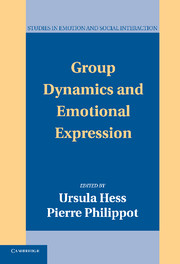
-
Select format
-
- Publisher:
- Cambridge University Press
- Publication date:
- 06 August 2009
- 29 January 2007
- ISBN:
- 9780511499838
- 9780521842822
- 9780521179393
- Dimensions:
- (228 x 152 mm)
- Weight & Pages:
- 0.418kg, 208 Pages
- Dimensions:
- (228 x 152 mm)
- Weight & Pages:
- 0.32kg, 210 Pages
- Subjects:
- Social Psychology, Psychology
You may already have access via personal or institutional login- Subjects:
- Social Psychology, Psychology
Book description
The study of emotional expressions has a long tradition in psychology. Although research in this domain has extensively studied the social context factors that influence the expresser's facial display, the perceiver was considered passive. This 2007 book focuses on more recent developments that show that the perceiver is also subject to the same social rules and norms that guide the expresser's behavior and that knowledge of relevant emotion norms can influence how emotional expressions shown by members of different groups are perceived and interpreted. Factors such as ethnic-group membership, gender and relative status all influence not only emotional expressions but also the interpretation of emotional expressions shown by members of different groups. Specifically, the research presented asks the question of whether and why the same expressions shown by men or women, members of different ethnic groups, or individuals high and low in status are interpreted differently.
Reviews
‘The book covers 35 years of research quite well … This collection will be of interest to social psychologists and their students, as well as to those just interested in better understanding the emotions shown by others.’
Richard Evenson Source: PsycCritiques
Metrics
Altmetric attention score
Full text views
Full text views help Loading metrics...
Loading metrics...
* Views captured on Cambridge Core between #date#. This data will be updated every 24 hours.
Usage data cannot currently be displayed.
Accessibility standard: Unknown
Why this information is here
This section outlines the accessibility features of this content - including support for screen readers, full keyboard navigation and high-contrast display options. This may not be relevant for you.
Accessibility Information
Accessibility compliance for the PDF of this book is currently unknown and may be updated in the future.


